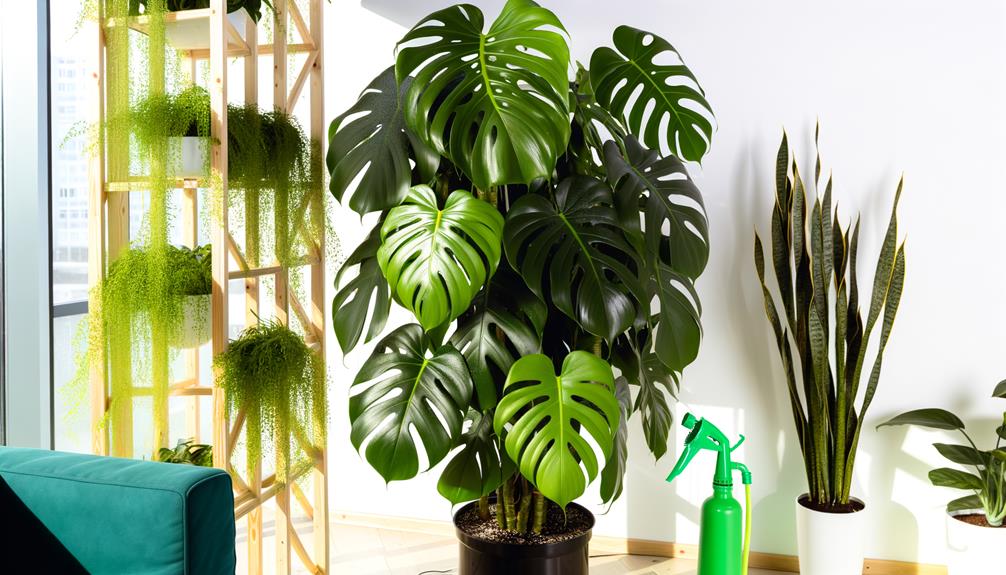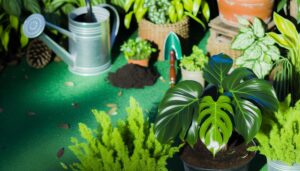Monstera Standleyana Indoor Care
Safeguard your Monstera Standleyana thrives by providing bright, indirect light near east or north-facing windows. Water when the top 2-3 inches of soil are dry, using well-draining soil with perlite or orchid bark.
Maintain humidity levels between 60% and 80%, using a hygrometer to monitor and humidifiers if needed. Choose pots with drainage holes and repot every 1-2 years.
Regularly inspect for pests like spider mites, mealybugs, and scale insects, treating promptly with appropriate methods. Use moss poles or trellises to support its growth.
If you adhere to these guidelines, you'll foster a healthy, vibrant plant.

Key Takeaways
- Provide bright, indirect light and avoid direct sunlight for optimal Monstera Standleyana growth.
- Water when the top 2-3 inches of soil are dry, using a well-draining soil mix.
- Maintain humidity levels between 60% and 80% using humidifiers or moisture trays.
- Inspect regularly for pests and treat spider mites with insecticidal soap or neem oil.
- Use moss poles or trellises to support and guide the plant's growth structure.
Light Requirements
Promoting ideal growth for your Monstera Standleyana involves providing bright, indirect light to replicate the plant's natural tropical habitat. Place it near an east or north-facing window, where it can receive filtered sunlight. Direct sunlight can damage the leaves, so avoid placing it in south-facing windows without sheer curtains.
If natural light is inadequate, you can supplement with full-spectrum fluorescent or LED grow lights. Aim for 10-12 hours of light daily to ensure optimal photosynthesis. Monitoring leaf color and growth patterns will help you evaluate light adequacy. Yellowing leaves may indicate excessive light, while leggy growth suggests insufficient light.
Adjust the plant's position as needed to maintain its health and vitality.
Watering Schedule
To maintain best growth for your Monstera Standleyana, you'll need to establish a watering schedule that considers frequency, soil moisture, and seasonal adjustments.
Monitor the soil moisture regularly, ensuring it remains consistently damp but not waterlogged.
Adjust your watering frequency based on seasonal changes, reducing water during the winter months when the plant's growth rate naturally slows.
Frequency of Watering
Proper watering of Monstera Standleyana is crucial, and you should water it when the top 2-3 inches of soil are dry to the touch. This typically means watering every 7-10 days during the growing season. Use a finger or moisture meter to assess soil dryness.
Remember, variations in room temperature, humidity, and light levels can alter this schedule. In winter, the plant's metabolic rate slows, requiring less frequent watering, roughly every 2-3 weeks.
Overwatering can lead to root rot, while underwatering can cause leaf browning. Always make sure excess water drains out to prevent waterlogging.
Consistently monitor and adjust based on your plant's specific environmental conditions to maintain optimal hydration and health.
Soil Moisture Needs
Monitoring soil moisture levels is essential for the health of your Monstera Standleyana, as it directly influences its hydration and root system integrity. You need to maintain a balance between overwatering and underwatering.
Use a moisture meter or insert your finger about 2 inches into the soil. The topsoil should feel dry before you water again. Guarantee even moisture distribution by watering thoroughly until water drains from the pot's bottom. This prevents waterlogging and root rot, while promoting healthy growth.
Opt for well-draining soil mixes containing components like perlite or orchid bark to improve aeration. Avoid letting your Monstera Standleyana sit in standing water, as it can lead to harmful fungal infections and compromised root health.
Seasonal Water Adjustments
As seasons change, the watering schedule for your Monstera Standleyana must be adjusted to account for variations in temperature and humidity, ensuring ideal hydration and plant health.
During warmer months, increased evaporation and transpiration necessitate more frequent watering. Conversely, in cooler months, reduced evaporation and slower growth demand less water. Monitor soil moisture to prevent over- or under-watering.
Spring/Summer:
Water when the top 2 inches of soil are dry.
Fall/Winter:
Allow the top 3-4 inches of soil to dry out before watering.
Humidity:
Maintain 60-70% humidity to reduce water loss.
Temperature:
Ideal range is 65-80°F; adjust watering frequency based on indoor climate changes.
These adjustments will help you maintain a thriving Monstera Standleyana year-round.
Humidity Needs
Maintaining high moisture levels, ideally between 60% and 80%, is crucial for the best growth of Monstera Standleyana. High moisture prevents leaf tips from browning and supports peak cellular function. Use a hygrometer to monitor indoor moisture accurately.
If levels fall below the ideal range, employ a humidifier to increase moisture in the air. Alternatively, place the plant on a moisture tray filled with water and pebbles, making sure the pot's base isn't submerged. Misting can also help but should be done regularly to maintain consistent moisture.
Avoid placing your Monstera near vents or drafty windows, as fluctuating air currents can decrease moisture levels, stressing the plant. Proper moisture ensures vigorous growth and lush foliage.
Soil and Potting
Choosing the right soil mix is crucial for Monstera Standleyana's health, as it requires well-draining, aerated soil to prevent root rot and promote robust growth. Aim for a mix that combines organic matter with components that improve drainage.
Here are key elements to include:
- Perlite: Enhances aeration and drainage, preventing waterlogging.
- Pine bark: Introduces organic matter, fostering a healthy root environment.
- Coconut coir: Retains moisture while allowing excess water to escape.
- Activated charcoal: Assists in absorbing impurities and preventing fungal growth.
Select a pot with drainage holes to further guarantee excess water can escape, reducing the risk of root rot. Repot every 1-2 years, revitalizing the soil to maintain nutrient availability and support ongoing growth.
Pruning Techniques
When you prune your Monstera Standleyana, make sure you do so during its active growing season, typically spring or early summer.
Use sterilized, sharp pruning shears to make clean cuts, minimizing plant stress and risk of infection.
Strategic pruning can promote new growth and maintain the plant's desired shape.
Timing for Pruning
Prune Monstera Standleyana during its active growing season, typically in spring or early summer, to encourage healthy growth and maintain its shape. Timing is essential as it allows the plant to recover quickly and channel energy into new growth.
You'll want to look for the following indicators before you start pruning:
- New growth: Signs like fresh leaves or shoots indicate that the plant is actively growing.
- Overcrowded stems: Pruning these can improve air circulation and light penetration.
- Damaged or diseased leaves: Removing these helps prevent the spread of pathogens.
- Leggy growth: Cutting back elongated stems can promote a bushier appearance.
Essential Pruning Tools
To effectively trim your Monstera Standleyana, you'll need a set of specific tools designed to make clean cuts and minimize plant damage. Start with sharp, sterilized pruning shears; dull blades can crush stems, increasing disease risk. Use a disinfectant like isopropyl alcohol to sanitize the shears before each use.
For thicker stems, a pair of bypass loppers provides the necessary leverage and precision. Additionally, a clean, sharp knife can be useful for making precise cuts on aerial roots. Always wear gloves to protect your hands from potential irritants and optimize you have a clean, stable cutting surface.
Encouraging New Growth
Strategically trimming your Monstera Standleyana not only shapes the plant but also stimulates robust new growth. To encourage the best possible development, focus on pruning techniques that enhance the plant's health.
Always use disinfected, sharp pruning shears to make clean cuts. Trim just above a node, as this is where new growth will emerge. Aim to prune during the growing season, typically in spring and summer, when the plant's energy is at its peak.
- Locate: Find the nodes where new leaves sprout.
- Disinfect: Clean your tools to prevent infection.
- Trim: Make precise cuts just above the node.
- Observe: Watch the plant for signs of new growth.
Common Pests
Monitoring your Monstera Standleyana for common pests like spider mites, mealybugs, and scale insects is crucial to maintaining its health. These pests can deplete nutrients, resulting in stunted growth and damage to foliage. Regular inspection, especially on the underside of leaves, aids in early detection and control. Use a magnifying glass for detailed examination.
Here's a quick reference table for common pests:
| Pest | Symptoms | Treatment |
|---|---|---|
| Spider Mites | Webbing, yellow spots | Insecticidal soap, neem oil |
| Mealybugs | White, cotton-like clusters | Alcohol-soaked cotton swabs |
| Scale Insects | Brown scales on stems and leaves | Horticultural oil, manually remove |
Prompt action guarantees pests don't compromise your plant's vigor. Always quarantine new plants to prevent infestations.
Supporting Growth
Ensuring your Monstera Standleyana thrives involves providing it with the right support structures to encourage robust growth and prevent stem damage. Use sturdy materials that mimic its natural climbing environment.
Here's how you can effectively support its growth:
- Moss Poles: These offer a textured surface that encourages aerial roots to anchor, promoting vertical growth.
- Trellises: Ideal for guiding stems in a desired direction, preventing tangling and breakage.
- Stakes: Simple yet effective, stakes provide immediate support for young or weak stems.
- Soft Ties: Use soft, flexible ties to gently secure stems to supports without damaging delicate tissues.
Conclusion
To sum up, if you follow these detailed care instructions, your Monstera standleyana will thrive like a well-maintained machine. Provide the appropriate light, water, and humidity, and guarantee proper soil and potting.
Regular pruning and vigilance against common pests will keep your plant healthy. Supporting its growth is the final touch to a flourishing indoor garden.
Remember, a little effort goes a long way in creating a green oasis at home. Happy gardening!






